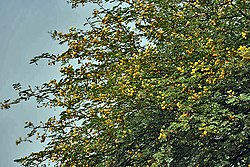| Vachellia nilotica | |
|---|---|
 | |
| Leaves and thorns | |
| Scientific classification | |
| Kingdom: | Plantae |
| Clade: | Tracheophytes |
| Clade: | Angiosperms |
| Clade: | Eudicots |
| Clade: | Rosids |
| Order: | Fabales |
| Family: | Fabaceae |
| Subfamily: | Caesalpinioideae |
| Clade: | Mimosoid clade |
| Genus: | Vachellia |
| Species: | V. nilotica |
| Binomial name | |
| Vachellia nilotica | |
| Subspecies | |
| |
 | |
| Range of Vachellia nilotica | |
| Synonyms [4] | |
Vachellia nilotica, more commonly known as Acacia nilotica, and by the vernacular names of gum arabic tree, [5] babul, [6] thorn mimosa, Egyptian acacia or thorny acacia, [7] is a flowering tree in the family Fabaceae. It is native to Africa, the Middle East and the Indian subcontinent.






